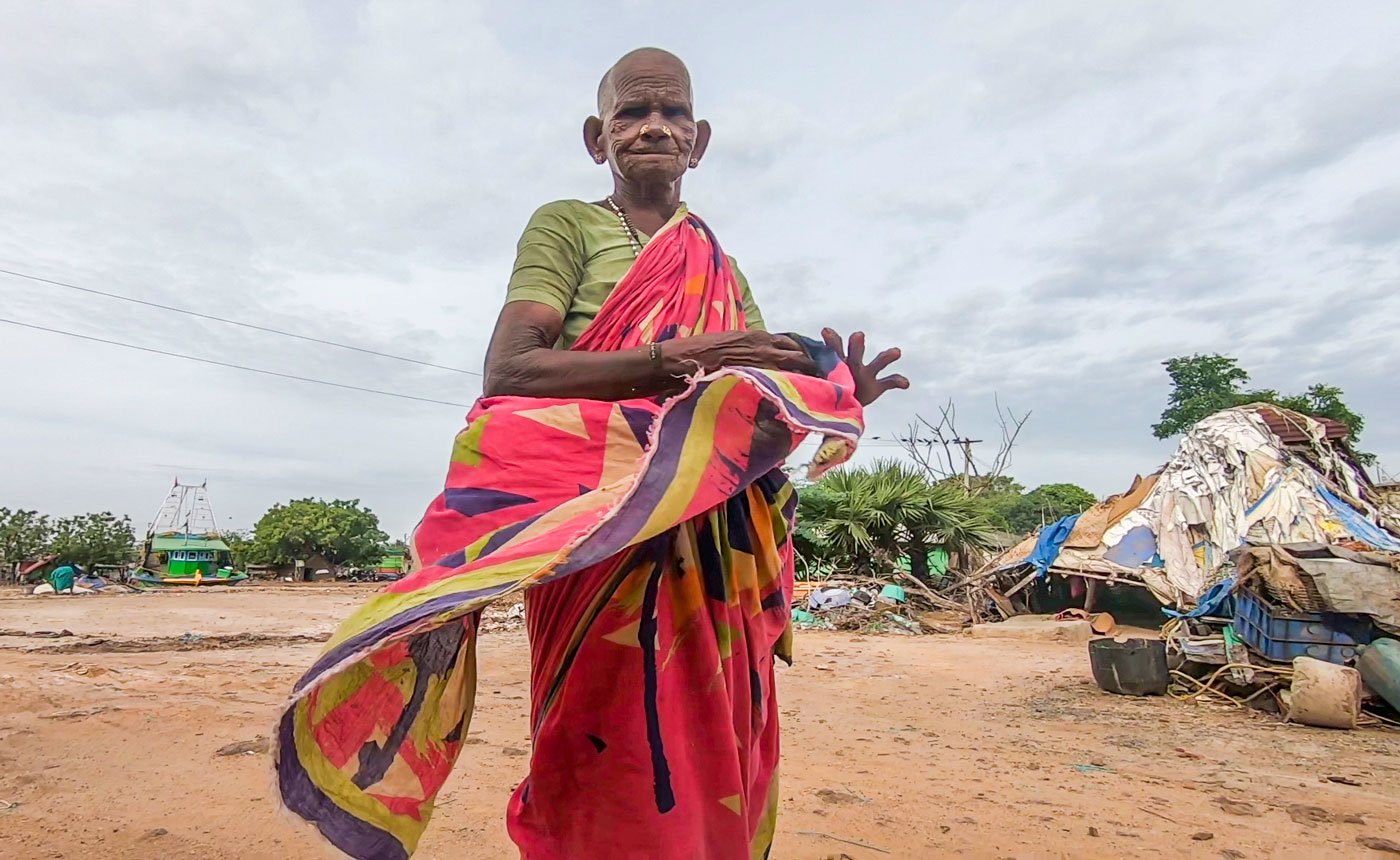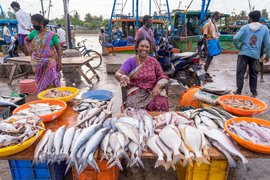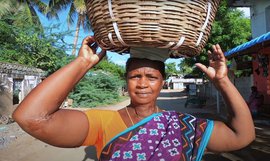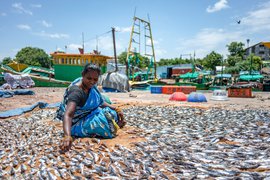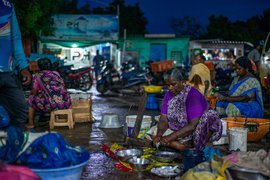বন্দরের লোকজন কে. ভানুমতীকে আজও 'পুলি' বলেই ডাকে, নামটা তাঁর দাদামশাইয়ের দেওয়া। তামিল ভাষায় এর অর্থ 'বাঘ', কারণ তাঁর দম যে ফুরোতেই চায় না। দরিয়ার কোল ঘেঁষে ৪০টা বছর পার করে দিয়েছেন বর্জ্য ঘেঁটে। বাতিল মাছ, মাছের আঁশ, কানকো ইত্যাদি জোগাড় করে বাছাই করেন তিনি, সেসব বেচেই পেট চলে তাঁর। তবে পুলি বা তাঁর মতো আর যেসব মহিলারা তামিলনাড়ুর মৎস্যবন্দরে কাজ করেন, সরকারি নিয়ম অনুযায়ী তাঁদের কেউই শ্রমিক নন, ফলত সুরক্ষা-কবচ অধরাই রয়ে গেছে আজীবন।
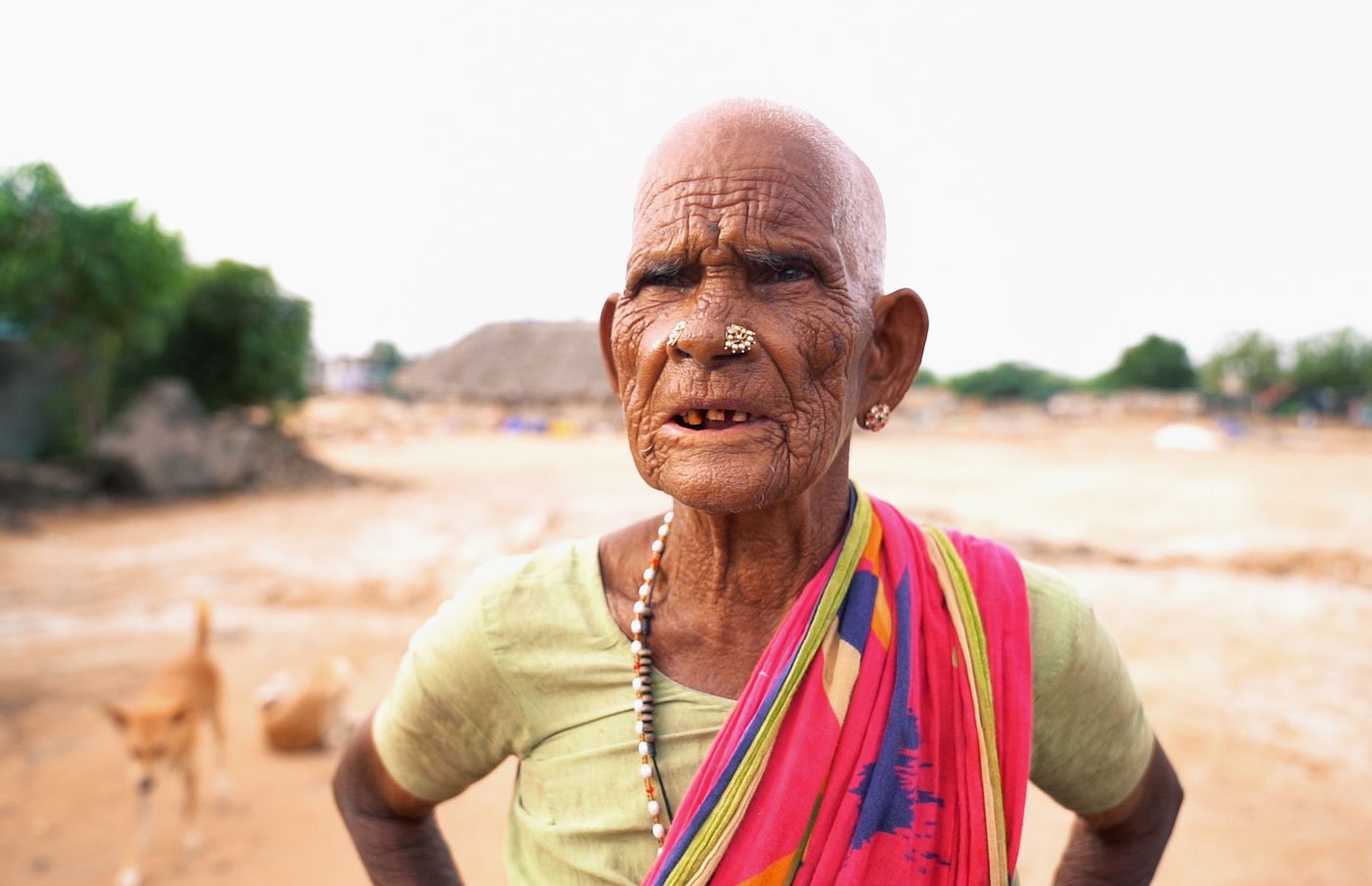
"এখানে এসে যখন উঠি, তখন প্রায় ৩৫ বছর বয়স আমার, মাছ নিলাম করা শুরু করি," জানালেন পুলি, আজ ৭৫ বছর বয়স তাঁর। কুড্ডালোরের পূর্বপ্রান্তে ওল্ড টাউন বন্দরটির তীরে নৌকা ভিড়লে নিলামদারের ইঙ্গিতে দরাদরি নিয়ে হাঁকডাক শুরু করে ব্যবসায়ীদের দল। নৌকাতে টাকা লাগালে বিক্রিবাটা থেকে ১০ শতাংশ কমিশন (বছর কুড়ি আগে অবধি এটা ৫ শতাংশ ছিল) বাবদ পান তাঁরা। সেই ৪০ বছর আগে পুলি যখন এই জাহাজঘাটায় এসে পৌঁছন, নিলামের কাজে তাঁকে হাতেখড়ি দেন আত্মীয়রা, দুটো নৌকায় পয়সা লগ্নি করতে হাজার পঞ্চাশেক ধারও দিয়েছিলেন তাঁরা – বছরের পর বছর হাড়ভাঙা খাটনি দিয়ে সে টাকাটা শোধ করেছেন পুলি। বয়েস বাড়ার সঙ্গে সঙ্গে নিলামের দায়ভার নিজের মেয়ের হাতে তুলে দিয়েছেন তিনি।
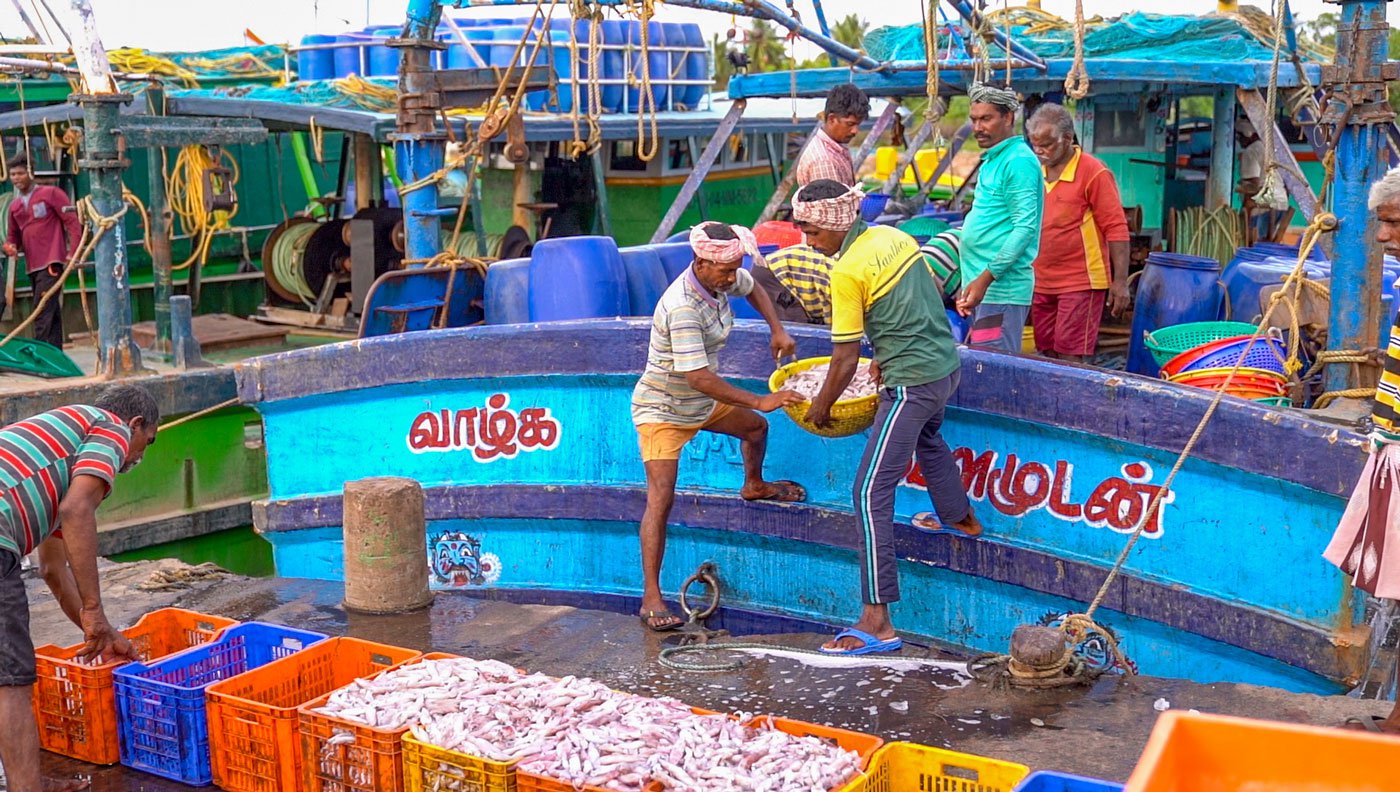
নিলামদারের হাঁকডাক, ব্যস্ত পায়ে ইতিউতি চলতে থাকা ব্যবসায়ীর দল, জালের মাছ স্থানান্তর করছে লোডার, যান্ত্রিক দাঁতে গুঁড়ো হওয়া বরফ, লরির আসা-যাওয়া, বিক্রিবাটায় মগ্ন মেছুয়া – নানান সব আওয়াজে চিরমুখর হয়ে থাকে জাহাজঘাটা। কুড্ডালোর জেলার অন্যতম মেছুয়া বন্দর এটি, সোথিকুপ্পম (পুলি যেখানে থাকেন) তথা আশেপাশের আরও চারটি গ্রামের মৎস্যজীবীদের কর্মক্ষেত্র। কেন্দ্রীয় সামুদ্রিক মৎস্যপালন গবেষণাকেন্দ্রের কথায়: বছর দশেক আগে অবধি এই পাঁচটি গ্রাম থেকে ২৫৬টি যন্ত্রচালিত ও ৮২২টি মোটর-চালিত নৌকা এসে ভিড়ত এখানে। (সাম্প্রতিক তথ্য বলতে এটা বই আর কিছু নেই।)
![“I’d started my kazhar business at the same time [as when I began working at the harbour],” Puli says, referring to her work of collecting and selling fish waste (the scales, heads, tails of fish, shrimp shells and other parts) and bycatch (such as seashells, shrimp, squid and small fishes). This is called kazhivu meen in Tamil, and, more informally, as kazhar. Puli is one of around 10 women at this harbour who collect fish waste and sell it to poultry feed manufacturers – it's a big industry in neighbouring districts like Namakkal. From Rs. 7 for one kilo of kazhar when she started out, the rate now, Puli says, is Rs. 30 per kilo for fish, Rs. 23 for fish heads and Rs. 12 for crab kazhar.](/media/images/04-Puli-3-NR-Puli_gets_by_on_shells_scales.max-1400x1120.jpg)
"একই সাথে (বন্দরে কাজ শুরু করার সময়) আমার কাঝারের ব্যবসাটাও শুরু করি তখন," জানালেন পুলি। 'কাঝার' বলতে চলতি ভাষায় মাছের বাতিল অবশিষ্টাংশ (আঁশ, মাথা, ল্যাজা, চিংড়ির খোলস ইত্যাদি) আর জালে পড়া টুকিটাকি জলজ প্রাণী (শামুক, ঝিনুক, চিংড়ি, স্কুইড, কুচো মাছ) জোগাড়যন্তর করে বেচার কথা বলতে চাইছিলেন তিনি। প্রমিত তামিলে এটাকেই 'কাঝিভু মীন' বলে। পুলি সেই জনা দশেক মহিলার মধ্যে পড়ছেন যাঁরা এই কাঝার সংগ্রহ করে পোল্ট্রির খাবারদাবার নির্মাতাদের কাছে বিক্রি করেন – আশেপাশের জেলায় (যেমন নামাক্কল) এটি রীতিমতো বড়ো বহরের একটি শিল্প। কাজে ঢোকার সময় কাঝারের দাম ছিল ৭ টাকা কিলো, তবে আজ মাছের জন্য ৩০ টাকা প্রতি কিলো, মুড়োর জন্য কিলো পিছু ২৩ টাকা আর কাঁকড়ার জন্য কিলোয় ১২ টাকা পান তিনি।
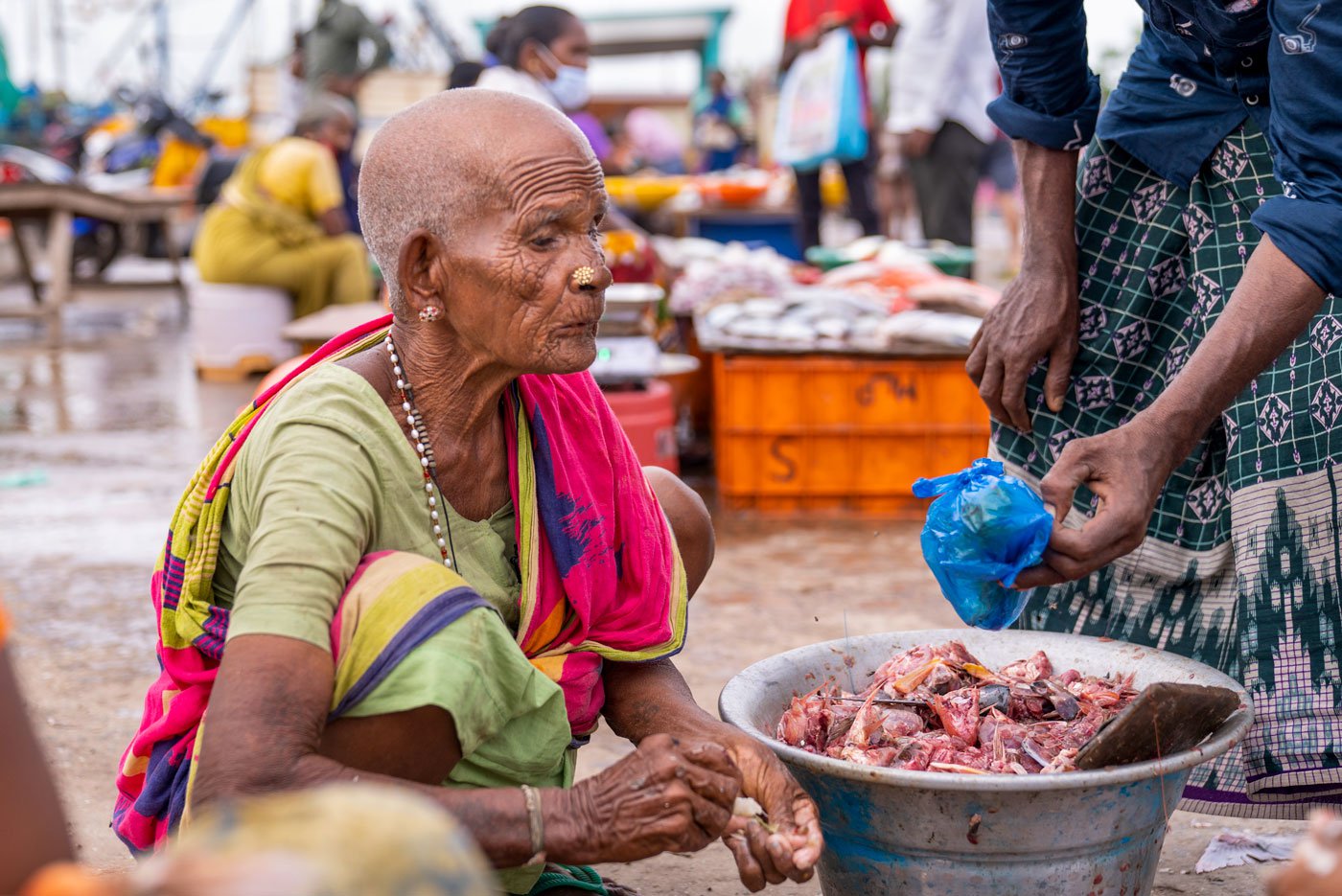
১৬ বছর বয়সেই নাগাপট্টিনম জেলার এক জেলের সঙ্গে বিয়ে হয়ে যায় পুলির। চার-চারটি সন্তান হয়েছিল বটে, তবে ওঁর স্বামী কুপ্পুসামির স্বভাবটা ছিল বড্ডো উগ্র। তাই বাচ্চাদের নিয়ে তাঁকে বাড়ি ফিরে আসতে বলেন পুলির বাবা, তিনি ছিলেন সোথিকুপ্পম পঞ্চায়েতের এক নেতা। বছর তিনেক বাদে পুলির মা মারা যান, নিলামের কাজে যুক্ত ছিলেন তিনিও। "ঠিক তখনই নিলামে নামার কথা বলে আমার আত্মীয়স্বজন," বললেন তিনি, "বাচ্চাগুলো বড়ো হচ্ছে তখন, চাট্টি টাকাপয়সার দরকার ছিল।"
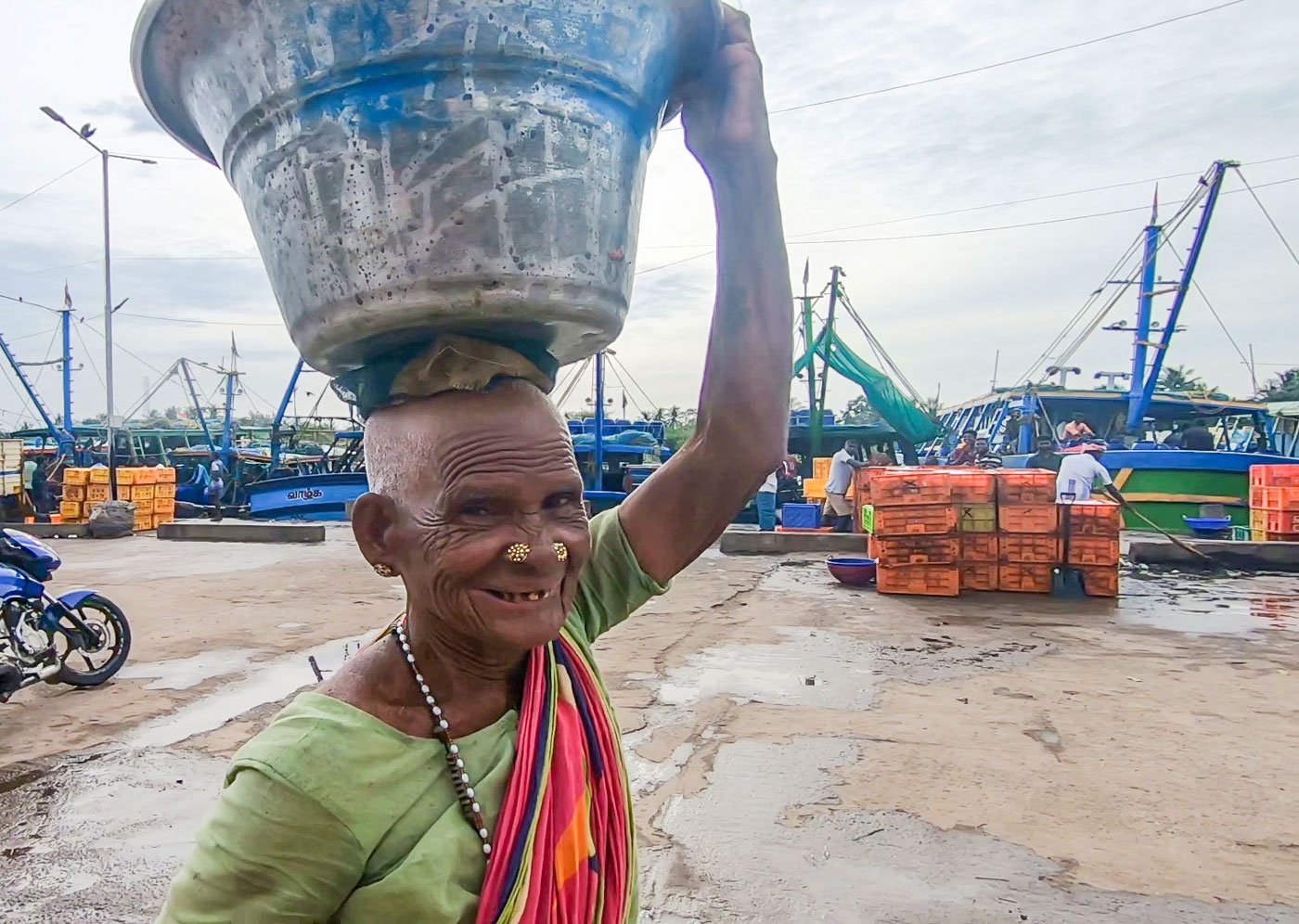
ভোররাত ৪টে থেকে সন্ধ্যা ৬টা অবধি বন্দরে দেখা যায় তাঁকে – নুনে জারিয়ে, বাঁধছাঁদ করে কাঝার বেচছেন। আঁশটে গন্ধ কাটাতে পয়লা দিনেই নুনে জারাতে হয়, দ্বিতীয় দিনে সেটা শুকিয়ে গেলে পরে জালিকাটা বস্তায় ভরে ফেলতে হয়। পুলি হয় জাহাজঘাটা থেকেই ৪ টাকা দিয়ে একেকটা ব্যাগ কেনেন, কিংবা পাটের তৈরি নুনের বস্তাগুলোই কাজে লাগান, সেগুলোর দাম আবার ১৫ টাকা পিস।
কাঝারের একেকটা বস্তার ওজন ২৫ কিলো, জানালেন পুলি। আগে প্রতি সপ্তাহে ৪-৫ বস্তা বিক্রি হত হেসেখেলে, কিন্তু কোভিড-১৯ অতিমারি শুরু হওয়ার পর থেকে ব্যাবসায় নামে মন্দা, নিষেধাজ্ঞা নামে আড়-জালের (রিং সেইন জাল) কেনাবেচাতেও, ফলত মাছের কারবারেও লালবাতি জ্বলার জোগাড়। হপ্তা গেলে দুটো বস্তার বেশি আর তুলে দিতে পারেন না নামাক্কলের ব্যবসায়ীদের হাতে। সপ্তাহ গেলে মেরেকেটে ১,২৫০ টাকা রোজগার হয় তাঁর।
নিলামদার, ক্ষুদ্র ব্যবসায়ী, মাছ শুকোচ্ছেন কেউ, কেউ বা ব্যস্ত কাঝার বাছাইয়ে – কুড্ডালোর বন্দরে হাজারো কাজ, সে কাজে নিযুক্ত মহিলারা জানালেন কেমনভাবে তাঁদের দৈনিক রোজগারে দেখা দিয়েছে অনিশ্চয়তা। জেলে গ্রামের যুবতীরা আজ আর মাছের কারবারে পা রাখতে চান না। ফলত কর্মরত অবস্থায় সেই বয়স্ক মহিলাদেরকেই দেখা যায় জাহাজঘাটায়।
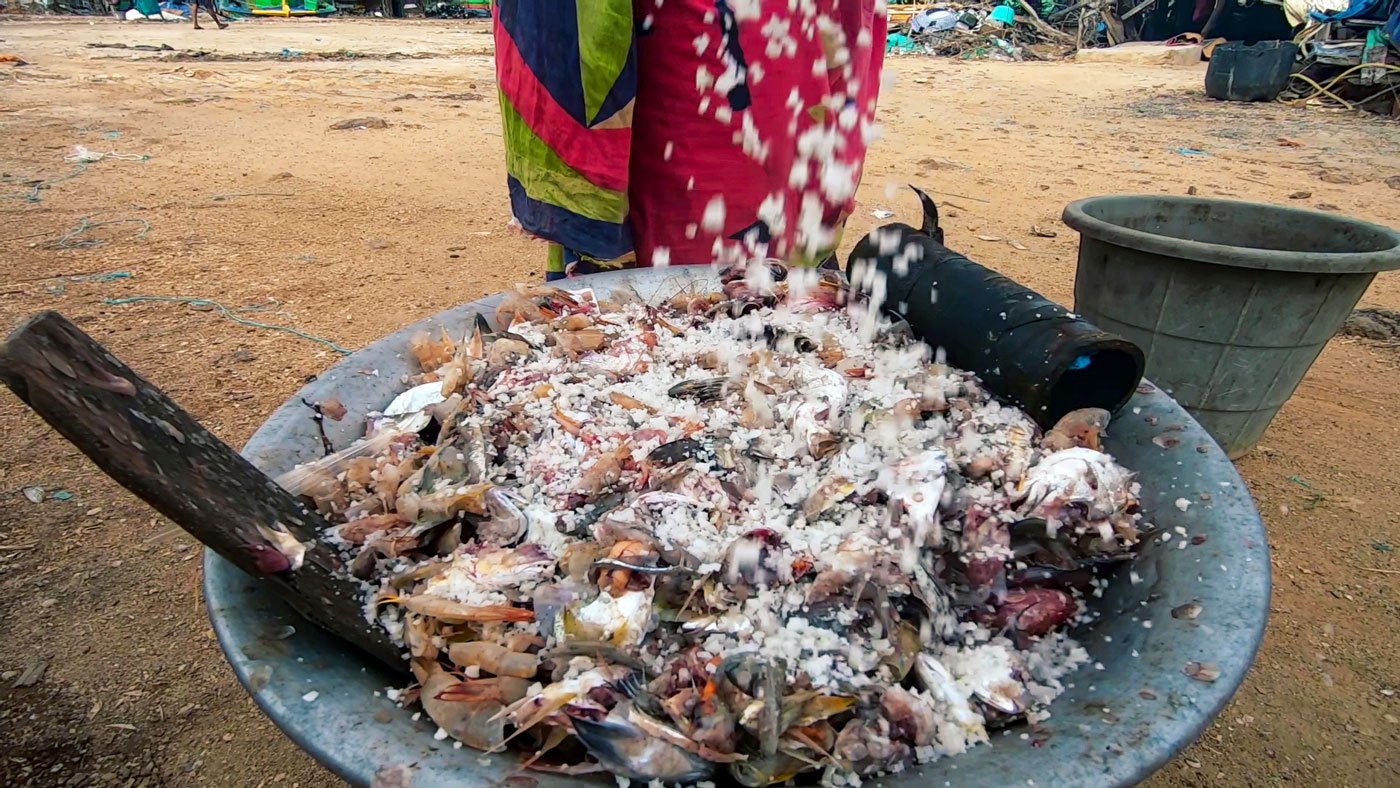
পুলির কথায়: "কাঝারের জন্য একটি পয়সাও দিই না, বন্দরে ওই যে মহিলারা মাছ কাটেন না? চেয়ে-চিন্তে ওদের থেকেই জোগাড় করে আনি।" খদ্দেরের চাহিদা মতন মাছের আঁশ আর নাড়িভুঁড়ি ছাড়িয়ে রাখেন মেছুনিরা, প্রতিদিন ভোর ৪টে বাজতে না বাজতেই সেসবের জোগাড়ে বেরিয়ে পড়েন পুলি। কাঝারের দাম দেন না ঠিকই, তবে মেছুনি আর মাছ-কাটিয়েদের জন্য হামেশাই ঠান্ডা পানীয় কিনে আনেন। "জায়গাটা সাফাই করতে সাহায্য করি ওদের, আড্ডা মারি, খবর-টবর চালাচালিও হয় দিব্যি," বলে উঠলেন তিনি।
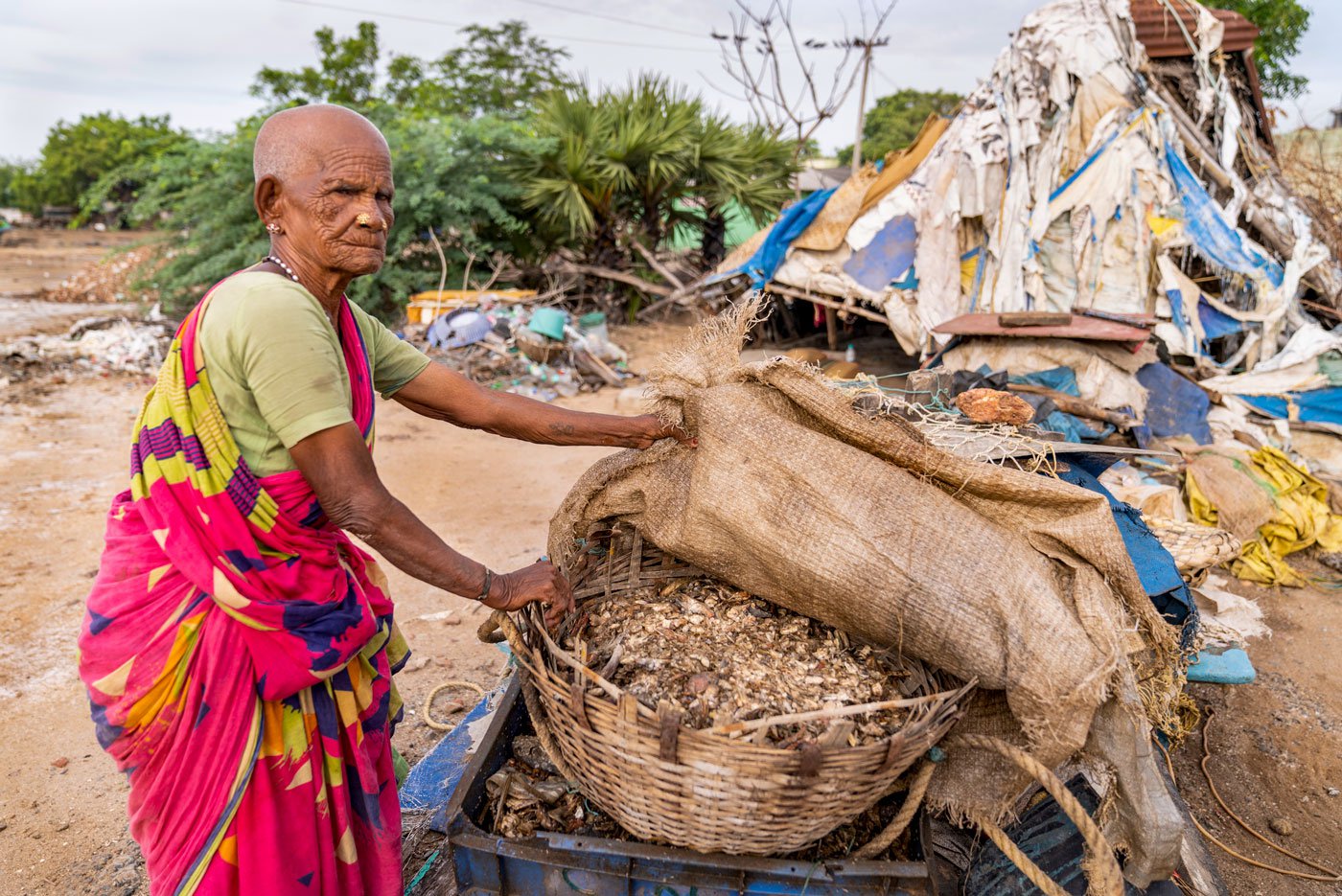
কুড্ডালোর বন্দরের মহিলারা মাছের ব্যবসা তথা প্রক্রিয়াকরণের সঙ্গে যুক্ত হরেক রকমের কাজ সামলান, তার পাশাপাশি রয়েছে হাজারো সহায়ক পেশা – যেমন মৎস্য ব্যবসায় কর্মরত মজুরদের জন্য চা, রান্না করা খাবার এবং বরফ বিক্রি করা। জাতীয় মৎস্যপালন নীতি ২০২০ বলছে যে মৎস্যপালনের দুনিয়ায় মাছ ধরার পর সেটা কাটছাঁট, জারানো, বস্তাবন্ধ করা ইত্যাদির কাজ যাঁরা করেন তাঁদের মধ্যে ৬৯ শতাংশ মহিলা। এই কাজগুলি ধরলে দেখা যাবে যে মৎস্যশিল্প বস্তুটি মূলত মহিলাদের কাঁধেই দাঁড়িয়ে রয়েছে।
সমবায়, যোজনা এবং অন্যান্য উপায়ে কর্মক্ষেত্রের পরিবেশের উন্নতি না ঘটালে মৎস্যপালনে মহিলাদের ভূমিকা বৃদ্ধি পাবে না, একথা স্বীকার করেছে ২০২০ সালের উপরোক্ত নীতি। তবে উক্ত যোজনাগুলি সাধারণত যান্ত্রিকীকরণের পিছনেই ছুটছে, মাছ ধরার পর সেগুলো কাটাকুটি, বাঁধাছাঁদা করার দৈনন্দিন কাজে মহিলারা যে অগুনতি সমস্যার সম্মুখীন হন, সে ব্যাপারে কারও কোনও হেলদোল নেই বললেই চলে।
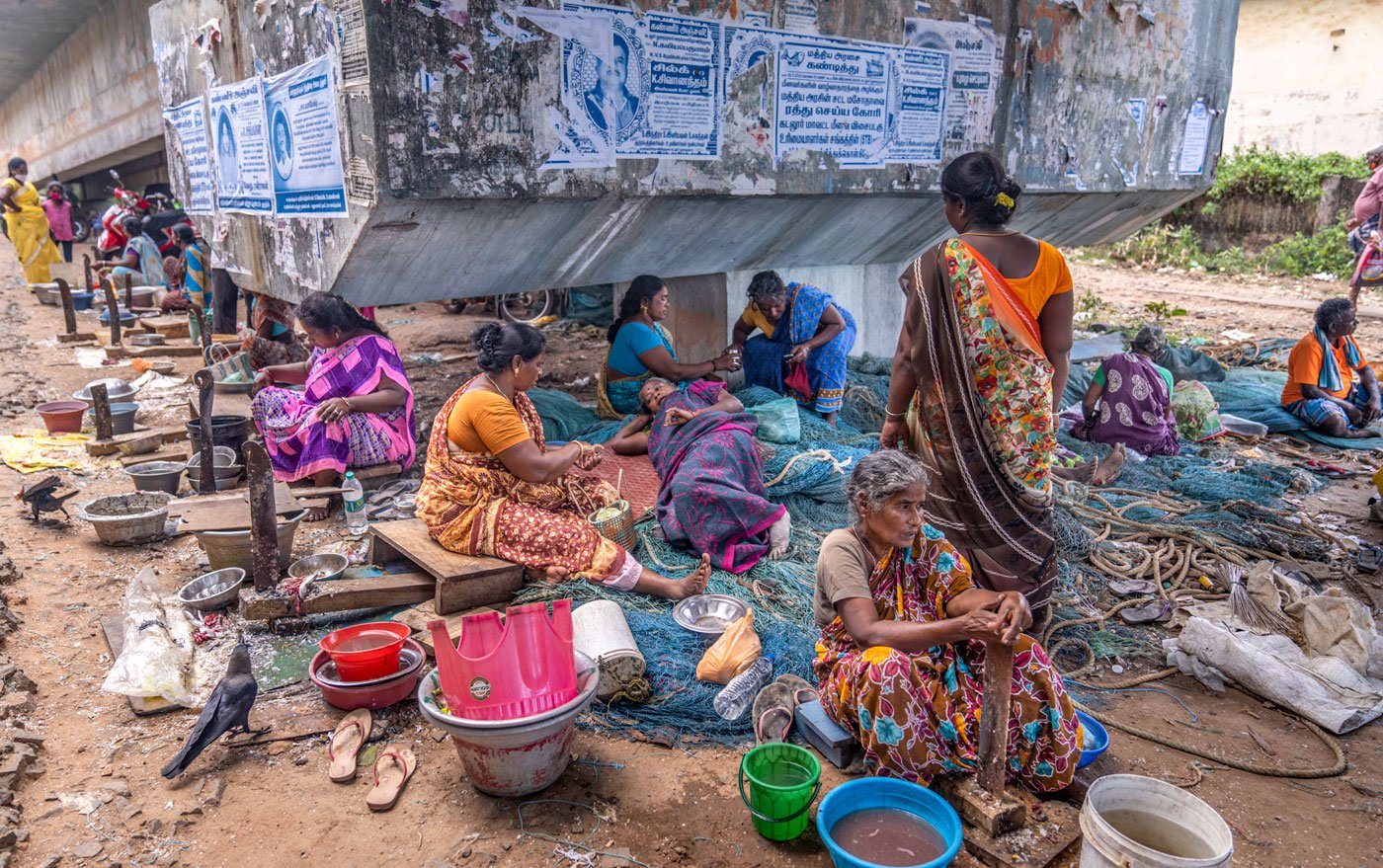
উপকূলবর্তী অঞ্চলে দ্রুত পরিবর্তন, পুঁজি-নিবিড় মৎস্যপালনের দিকে নীতিগত মোড় এবং রপ্তানির তেলা মাথায় তেল দেওয়ার ফলে মৎস্যজীবী মহিলাদের জীবনে সাহায্যের বদলে নেমে এসেছে দুর্দশার করাল গ্রাস, দিনকে দিন কোণঠাসা হয়ে যাচ্ছেন তাঁরা। মৎস্যপালনের জগতে নারীর যে বিশাল অবদান, উক্ত পরিবর্তনের দিশা তার প্রতি অবিচার বই আর কিছুই করছে না। কোণঠাসা হওয়ার পিছনে আরও দুটি কারণ রয়েছে, যেমন বৃহত্তর কাঠামোর পিছনে পুঁজি নিয়োগ এবং ১৯৭২ সালে স্থাপিত হওয়া সমুদ্রজাত পণ্য রপ্তানি উন্নয়ন কর্তৃত্ব, যেটির ফলে কৌম স্তরে মৎস্যপালনের বদলে জোর দেওয়া হয়েছে রপ্তানিতে। এই ঋণাত্মক প্রক্রিয়াটি ২০০৪ সালে সুনামির কারণে পুনর্জন্ম লাভ করেছে, যেহেতু নতুন নৌকা আর সাজসরঞ্জামের পিছনে একলাফে বেড়ে গিয়েছিল পুঁজির নিয়োগ।
মাছ ধরার পরের প্রক্রিয়া থেকে ক্রমশই বাদ পড়ে যাচ্ছেন স্থানীয় মহিলারা। বিক্রিবাটা, কাটাকুটি, শুকনো করা এবং সাফসাফাইয়ের জন্য যে জায়গাটুকু দরকার, সেটা কমে আসছে দ্রুত, একথা শোনা গেল কুড্ডালোর জাহাজঘাটার মহিলাদের গলায়। সরকারি সংস্থা থেকে বরফ রাখার বাক্স পেয়েছেন, বা গ্রামেগঞ্জের বাজারে তাঁদের জন্য আলাদা করে জায়গা ছেড়ে রাখা হয়েছে – এমন মহিলার সংখ্যা গুটিকয়। পরিবহণ ব্যবস্থারও বেহাল দশা, অধিকাংশ ক্ষেত্রেই দেখা যায় যে মাছ বেচতে পায়ে হেঁটে মাইলের পর মাইল পাড়ি দিতে হচ্ছে তাঁদের।
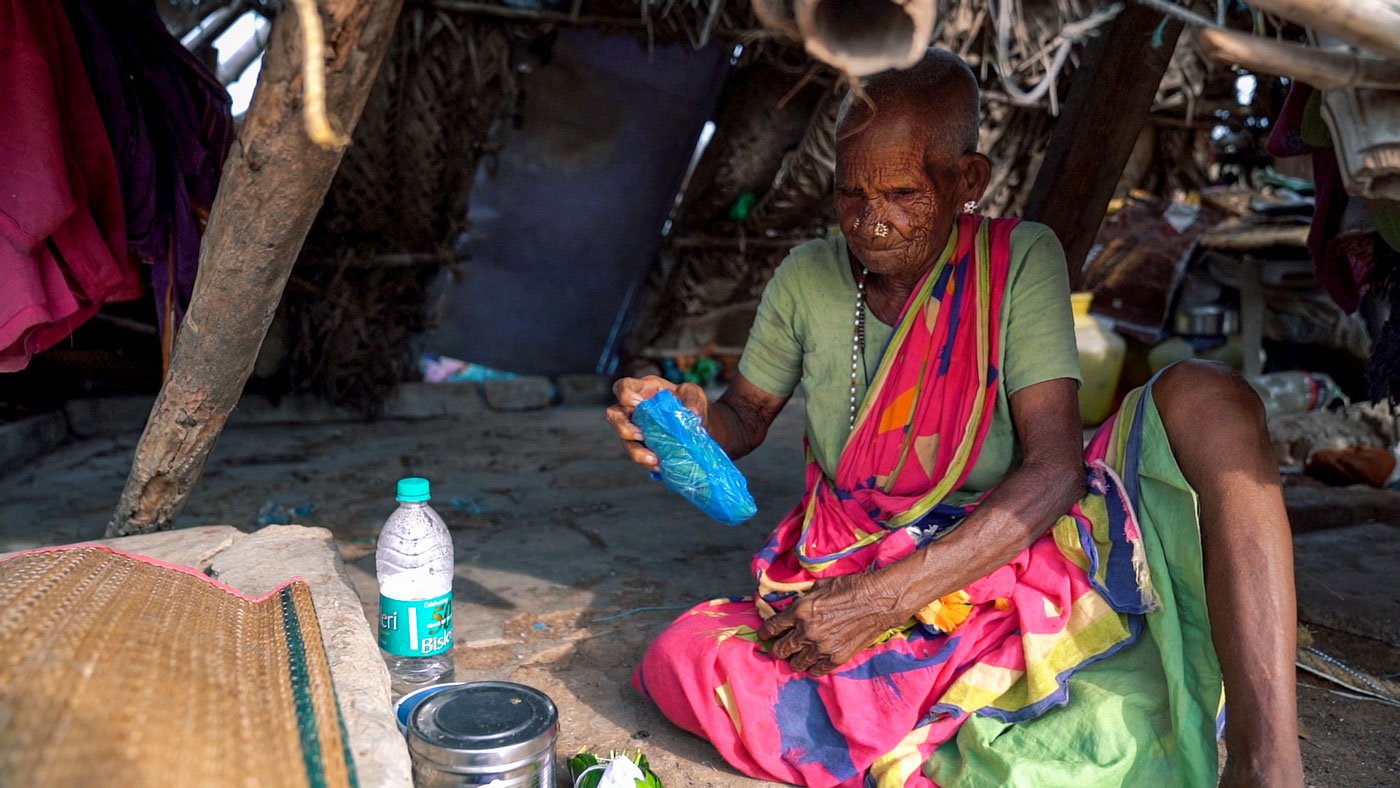
"আমি তো এই বন্দরেই একটা ঝুপড়ি বেঁধে থাকি, বিকিকিনির জায়গাটা হাতের কাছে না রাখলে হবে?" বলে উঠলেন পুলি। তবে বৃষ্টিবাদলার দিনে তিন কিলোমিটার দূরে সোথিকুপ্পমে তাঁর ছেলে মুথুর বাড়িতে গিয়ে ওঠেন। পেশায় মৎস্যজীবী মুথুও (৫৪) কাজ করেন এই জাহাজঘাটাতেই, মা কাজে ব্যস্ত থাকেন বলে প্রতিদিন তাঁর জন্য খাবার এনে দেন তিনি। মাস গেলে ১,০০০ টাকা বার্ধক্য ভাতা পান পুলি। মাছ বেচে যেটুকু হাতে আসে, তার প্রায় পুরোটাই ছেলেমেয়েদের পাঠিয়ে দেন তিনি। সন্তান বলতে দুটি মেয়ে ও দুটি ছেলে – চারজনেরই বয়েস ৪০ বা ৫০-এর কোঠায়, আষ্টেপৃষ্ঠে তাঁরা প্রত্যেকেরই বাঁধা পড়ে গেছেন কুড্ডালোর জেলার মৎস্যপালনের জগতে। "যাওয়ার সময় সঙ্গে করে কী-ই বা নিয়ে যাব বলুন দেখি?" প্রশ্ন ছুঁড়ে তার জবাবটাও দিয়ে দিলেন পুলি নিজেই: "কিস্যুটি না।"
সাহায্য করেছেন ইউ. দিব্যাউথিরন।
অনুবাদ: জশুয়া বোধিনেত্র (শুভঙ্কর দাস)
